KICKING UP A STINK - BARBARA WOODHOUSE'S PERPLEXING POUCHED SKUNK
 The late Barbara Woodhouse on the front cover of one of her books, No Bad Dogs: The Woodhouse Way (© Barbara Woodhouse/Summit Books – reproduced here on a strictly educational, non-commercial Fair Use basis for review purposes only)
The late Barbara Woodhouse on the front cover of one of her books, No Bad Dogs: The Woodhouse Way (© Barbara Woodhouse/Summit Books – reproduced here on a strictly educational, non-commercial Fair Use basis for review purposes only)I've said it before, but it's well worth repeating - mystifying creatures can turn up in the most unexpected locations, and the following example is certainly no exception.
To those of us of a certain age, the name Barbara Woodhouse is fondly associated with the staccato cry "Walkies!", uttered by a Joyce Grenfellesque lady of the genteel English schoolma'am variety that, sadly, seems to have quietly expired in these much more thrusting, belligerent modern times. She acquired national - indeed, international - fame rather late in life, aged 70, when in 1980 her idiosyncratic show 'Training Dogs The Woodhouse Way' was first screened on British television and soon attained cult status, as a result of which she became one of the most recognisable, and parodied, personalities of the '80s.
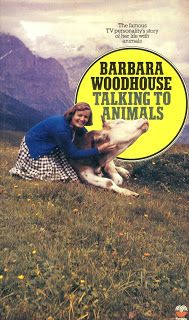 The Fontana paperback edition of Talking To Animals that I own (© Barbara Woodhouse/Fontana Books – reproduced here on a strictly educational, non-commercial Fair Use basis for review purposes only)
The Fontana paperback edition of Talking To Animals that I own (© Barbara Woodhouse/Fontana Books – reproduced here on a strictly educational, non-commercial Fair Use basis for review purposes only)Nevertheless, there seemed to be no connection between the redoubtable Ms Woodhouse and cryptozoology - at least, that is, until the 1990s, when I was reading through her autobiography Talking To Animals (1954), and, while perusing a section concerning her life as a young woman training horses in Argentina, stumbled upon the following fascinating, but very perplexing, paragraph:
Shortly after the storm [she had been describing the aftermath of a very violent storm that had hit their estate the previous evening], the foreman's little son came rushing up to say that all his pet rabbits had gone and that in the cage instead was a baby skunk. The mother had perished in the storm and lay dead by the cage. How that living little skunk had got into the undamaged cage, and the rabbits out of it, was beyond our understanding. In the mother's pouch were two dead babies. Experts cannot account for a skunk with a pouch, and try to persuade me that she was a 'possum. But she was no 'possum: she had the bushy tail of a skunk and was identical with the skunk picture in Cassell's Book of Knowledge. She did have a pouch: I examined her closely.
Woodhouse then went on to describe how she attempted to care for the alleged baby skunk by rearing it and feeding it in a cottonwool-lined pocket of her riding skirt, noting that it successfully fed and survived in this makeshift pouch for a week before ultimately dying after escaping from the pouch one night and becoming severely chilled.
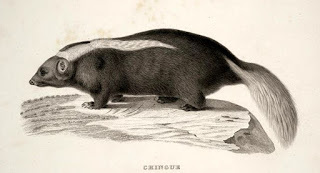 An engraving from 1848 depicting the Andean hog-nosed skunk (public domain)
An engraving from 1848 depicting the Andean hog-nosed skunk (public domain)Skunks, of which there are at least ten recognised species, were traditionally classed as mustelids (members of the weasel family), but more recently, based upon genetic studies, these infamously malodorous mammals have been allocated a taxonomic family of their own. However, although they do exhibit quite a diversity of morphologies, none of them has a pouch – a taxonomically-significant anatomical feature specific to marsupials. Moreover, only the hog-nosed skunks (genus Conepatus, constituting 4-5 species, depending upon opinion) are native to South America, and only two of these species are known to occur in Argentina – the Andean C. chinga in some of this vast country's northern regions, and the Patagonian C. humboldtii throughout much of its southern portion.
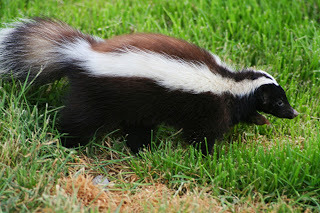 The Patagonian hog-nosed skunk (© Payayita/Flickr –
CC BY-SA 2.0 licence
)
The Patagonian hog-nosed skunk (© Payayita/Flickr –
CC BY-SA 2.0 licence
)Consequently, I find myself in agreement with the unnamed experts who claimed that Woodhouse's 'pouched skunk' was a 'possum - or, to be accurate, an American opossum, of which many species in several genera have been described. Having said that, the fundamental problem with this identity is that none of the known species of American opossum bears any real degree of similarity to a skunk.
True, the black-shouldered opossum Caluromysiops irrupta has distinctive black shoulders, a black dorsal stripe, and dark feet and tail that contrast markedly with the much paler fur on the rest of its body, but it is hardly skunk-like. And the distal portion of its tail is unfurred and rat-like, thereby bearing no resemblance to the uniformly furred tail of a skunk.
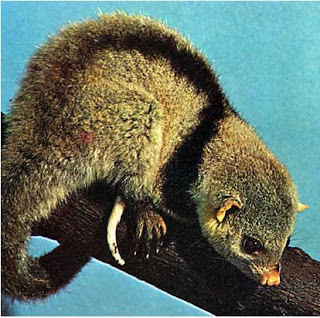 Photograph of the black-shouldered opossum (© owner's identity unclear to me; I found this picture on Globalspecies.org's
page
for the species – it is now reproduced here on a strictly educational, non-commercial Fair Use basis for review purposes only)
Photograph of the black-shouldered opossum (© owner's identity unclear to me; I found this picture on Globalspecies.org's
page
for the species – it is now reproduced here on a strictly educational, non-commercial Fair Use basis for review purposes only)Conversely, there is another species, Glironia venusta, which is actually known as the bushy-tailed opossum because of its unusually thick, densely-furred tail; however, it lacks any black-and-white fur colouration reminiscent of a skunk's, and as with the previous species its tail's distal portion is unfurred.
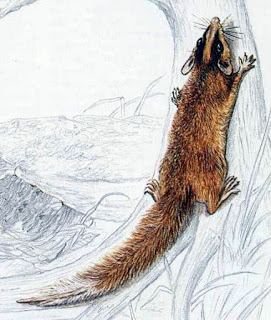 Illustration of the bushy-tailed opossum (© owner's identity is unclear to me; I found this illustration on
Wikipedia
, and it is now reproduced here on a strictly educational, non-commercial Fair Use basis for review purposes only)
Illustration of the bushy-tailed opossum (© owner's identity is unclear to me; I found this illustration on
Wikipedia
, and it is now reproduced here on a strictly educational, non-commercial Fair Use basis for review purposes only)Even the yapok or water opossum Chironectes minimus, whose distinctive black and pale grey fur may conceivably invite comparisons with skunks by observers poorly acquainted with these latter mammals, can be readily eliminated from further consideration by virtue of its very slender, wholly unfurred tail.
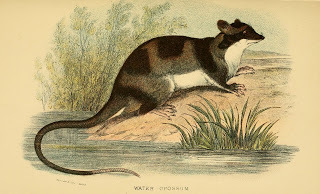 Illustration of a yapok from Dr Richard Lydekker's volume A Hand-Book to the Marsupialia and Monotremata (1896) (public domain)
Illustration of a yapok from Dr Richard Lydekker's volume A Hand-Book to the Marsupialia and Monotremata (1896) (public domain)As for the thick-tailed or lutrine opossum Lutreolina crassicaudata (aka the little water opossum), its pelage (especially in females) also has dark and light markings, though these are far less prominent than those of the yapok; however, it has a thicker tail than the yapok, but this is still far less bushy than that of a skunk. Moreover, of the species noted here, only the yapok and the thick-tailed opossum are native to Argentina anyway.
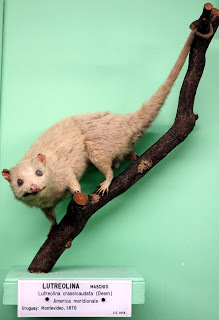 Taxiderm specimen of a thick-tailed opossum at Italy's Museo Civico di Storia Naturale di Genova (public domain)
Taxiderm specimen of a thick-tailed opossum at Italy's Museo Civico di Storia Naturale di Genova (public domain)So what could Woodhouse's pouched skunk have been? I have even considered briefly the possibility that the adult female animal found dead was a genuine skunk that was heavily pregnant, and that the shock of the storm had caused one of her babies to be born prematurely, with Woodhouse mistaking this mother skunk's vagina and uterus for a pouch! However, this all seems highly improbable, especially as Woodhouse was someone with considerable experience from a very early age at caring for and handling animals.
I would have dearly loved the opportunity to contact Barbara Woodhouse in order to elicit more details concerning her baffling little beastie, but, sadly, she died in 1988, well before I discovered her account of it in her book. There is still one way, however, of shedding, perhaps, just a little more light on this mystery.
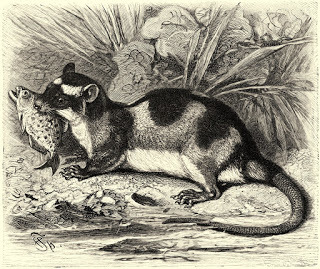 Exquisite 1800s engraving of a yapok (public domain)
Exquisite 1800s engraving of a yapok (public domain)Does anyone out there have a copy of Cassell's Book of Knowledge, which I am assuming must date from around the 1920s or 1930s, bearing in mind that Barbara Woodhouse was born in 1910 and lived in Argentina for more than three years during her 20s? If so, I'd love to see its picture of a skunk, because this would give some idea of what her supposed pouched variety looked like (bearing in mind that there are several very different skunk morphologies, depending upon the species in question). That in turn may provide clues as to its real identity – unless, of course, by any remote chance it really was a pouched skunk, and thereby constituted a still-undescribed and dramatically different species?
This ShukerNature blog article is excerpted from my book Karl Shuker's Alien Zoo: From the Pages of Fortean Times .
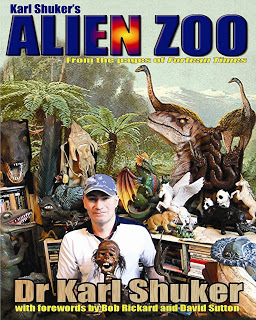
Published on December 14, 2017 16:20
No comments have been added yet.
Karl Shuker's Blog
- Karl Shuker's profile
- 45 followers
Karl Shuker isn't a Goodreads Author
(yet),
but they
do have a blog,
so here are some recent posts imported from
their feed.



